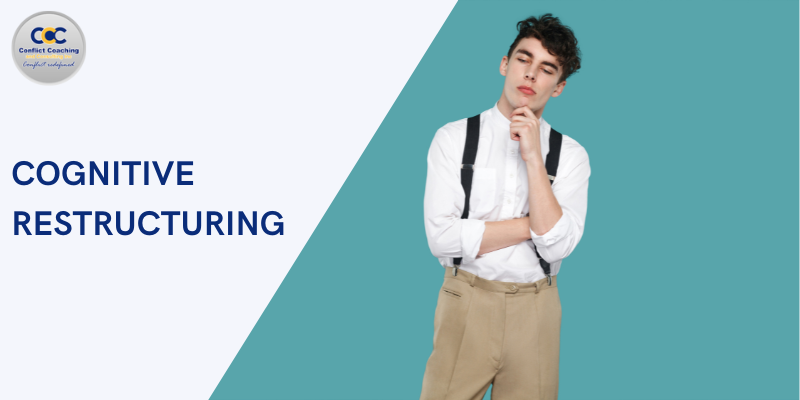
Cognitive Restructuring: What is it, Steps, Example, and Techniques
According to the National Institute of Mental Health, an estimated 19.1% of U.S. adults had any anxiety disorder in the past year, and an estimated 31.1% of U.S. adults experienced any anxiety disorder at some time in their lives.
Therefore, techniques such as cognitive restructuring can help individuals suffering from mental health disorders such as anxiety by altering behaviors and thought patterns.
Keep on reading to find out what cognitive restructuring is and how it works.
What is cognitive restructuring?
Cognitive restructuring is a group of therapeutic techniques with its foundation rooted in cognitive behavioral therapy. Cognitive restructuring techniques help clients identify their negative or irrational thought patterns and replace them with more accurate beliefs.
Cognitive restructuring can help reduce an individual’s stress, anxiety, and other mental and physical health conditions.
Let us now look into how this technique works.
How does cognitive restructuring work?
Cognitive restructuring is a methodology in cognitive behavioral therapy that is highly focused on changing irrational ways of thinking that often cause anxiety or stress. It assists individuals in replacing these irrational thoughts with more realistic patterns of thinking.
A behavioral therapist works with their clients to identify negative thought patterns and guide them toward how these affect their behaviors and emotions. This self-analysis is the very first and important step of restructuring as it recognizes the roots of an individual’s stress or anxiety.
Certain methods are employed in cognitive restructuring to confront and alter these harmful thought habits. For example, people are trained to recognize cognitive distortions, which are problematic thought patterns. Some common distortions include:
- Catastrophizing: where an individual assumes the worst will happen.
- Black-and-white thinking: Seeing things in black-and-white, with no room for compromise.
- Personalization: Holding oneself responsible for circumstances that are out of one’s control.
- Mind reading: An unsupported belief that you know what other people are thinking. People can improve their everyday functioning and emotional resilience by identifying and correcting these distortions and forming healthy thought habits.
7 Steps in cognitive restructuring
Cognitive restructuring is a technique of cognitive behavioral therapy that helps in replacing cognitive distortions with more helpful and balanced thought patterns.
Let us now walk through some of the key steps to understand how cognitive restructuring works:
1. Identify negative thoughts
The very first step in cognitive restructuring is identifying negative thoughts. But what does that mean? Individuals often suffer from negative thought patterns without even realizing that they are stuck in this loop.
For example, someone may think and believe that they are a failure. This negative, distorted thought pattern impacts an individual’s emotions.
Here it is essential to guide an individual to acknowledge and recognize this thought pattern because it turn makes one realize the thoughts that impact their mood.
2. Analyze thought patterns
Once an individual is guided toward identifying their negative thoughts, the next step in cognitive restructuring is to analyze these thought patterns.
This analysis involves trying to find patterns and common cognitive distortions such as blaming yourself for events that are beyond your control (personalization), all-or-nothing thinking or expecting the worst out of every situation.
This analysis is essential to help an individual see more clearly why certain situations are triggering for them and prompt extreme emotions and thoughts.
3. Challenge the thoughts
In the third step of cognitive restructuring individuals are guided towards challenging the negative thought patterns they have identified and analyzed. This is done through asking questions such as “What evidence do I have to support this thought?” or “What are some situations which have contradicted this thought?”
Through looking for evidence individuals can better understand which thoughts are accurate and which are embedded in distortion. Through challenging thoughts, individuals break their unhealthy pattern of believing every thought and learn to be more objective which in turn reduces stress.
4. Generate alternative thoughts
Challenging negative thoughts is essential, but what follows is even more essential to cognitive restructuring. Creating an alternative thought pattern is extremely important.
These alternative thoughts are to provide a more realistic, objective, and positive way of thinking. Therefore, in this way, individuals replace their harmful thinking patterns with thoughts that improve mental health or well-being.
5. Test new perspectives
For individuals to truly believe their alternative thoughts that are reinforced in the previous step it is essential to test these new perspectives in real-life situations. The individuals observe the impact of these alternative thoughts on their emotions.
6. Reflect on changes
Once an individual has started testing out these new perspectives, it is also essential to reflect on these changes. But why is this important? Once an individual reflects on how these new healthier thinking techniques taught to them through cognitive restructuring impact their moods and behavior.
Once individuals realize and see the benefits of this cognitive restructuring, they will be more inclined to continue using these techniques.
7. Practice regularly
Cognitively restructured thought patterns to become a natural response, individuals need to practice utilizing these techniques regularly. It is through consistency that cognitive restructuring can lead to less stress and emotional stability.
Example of a cognitive restructuring strategy
Here is an example of how cognitive restructuring can help an individual move past their mental distortions and adopt healthier ways of thinking and managing their emotions:
Amna is a young girl in her twenties, starting her very first job after graduating from university. She suffers from social anxiety and self-doubt. Due to this, she suffers from thoughts such as “Everyone will think I do not know what I am talking about” or “What if I embarrass myself”. Due to this, she suffers at her new job in various ways: she is unable to make connections in the workplace take initiative, and lead in projects.
Amna decides to opt for therapy to help her with her problems and mental distress. The therapist first guides Amna and helps her recognize her negative thought patterns and how they impact her emotions and behaviors.
The next step that the therapist takes to help Amna in this process is challenging her cognitive distortions. Amna is encouraged to ask herself and look for evidence to prove her self deprecating thoughts. “What evidence do I have that people think I do not know what I am talking about?”. Amna starts to recognize that reality is different from what her thoughts are forcing her to believe.
Alternative thought generation is the next step the therapist takes for Amna. Here she is encouraged to replace her automatic negative thoughts with more balanced thoughts. Through consistent practice, slowly Amna becomes more confident and comfortable in this balanced way of thinking.
Amna slowly tests out what she has learned in therapy in real-world situations and builds her confidence further which helps her strengthen her positive way of thinking even further.
10 Cognitive restructuring techniques
Cognitive restructuring is a way to change negative thoughts into positive ones. Here are 10 easy techniques you can use to get started:
1. Identifying Negative Thoughts
The most essential step of cognitive restructuring strategy is the identification of negative thoughts. While at some level it is part of being human to get caught up in cognitive distortions and believe thoughts that are self-deprecating and doubtful.
Therefore, it is foundational to take note of these thoughts and analyze how these thoughts are impacting oneself in terms of mood and behaviors which gives an individual better clarity on what they need to work on and change to improve their mental health.
2. Challenging Cognitive Distortions
You must be wondering what cognitive distortions are. Cognitive distortions are those irrelevant or negative thought patterns that can lead you to believe a reality that is inaccurate that is distorted in nature.
Some common types of distortions include catastrophizing, expecting the worst outcome, all-or-nothing thinking, viewing things as either all good or all bad, overgeneralization, and mental filtering.
3. Thought Recording
Suppose an individual opts for a therapist who utilizes cognitive behavioral therapy, whether it is for anger, anxiety, or any other mental distress. In that case, a therapist will use cognitive restructuring as a methodology. Moreover, with this method, thought recording is an extremely important step.
Let us now understand what thought recording refers to. Writing down thoughts through journaling gives an individual a chance to reflect on their emotions and can help them identify any patterns, which is important in restructuring any cognitive distortions.
Therapists highly encourage writing down thoughts as a form of self-reflection and self-investigation.
4. Evidence testing
Cognitive distortions are based on thought patterns and beliefs that are untrue, exaggerated, or self-deprecating. Therefore, in the process of cognitive restructuring, one essential step is evidence testing.
What does evidence testing refer to? It means challenging your thoughts and probing individuals to look for evidence that can either prove or disprove the beliefs you hold about yourself or the world around you.
Through looking for evidence individuals are forced to realize that there may be no real evidence for some of their distorted thoughts and they slowly move towards a more healthy way of thinking.
5. Alternative thought generation
Once an individual has collected the evidence that their thoughts hold no real merit and are distortions that their self-doubt has created it is not time to create alternative ways of thinking.
This is a process in which a therapist guides an individual in reframing their negative thoughts to more positive or neutral ones. For example, “I always fail at everything” can be replaced with “I try my best and put in my best efforts.”
Therefore, through this consistent practice of alternative thought generation, an individual slowly starts to build a healthier way of thinking, reducing self-doubt and improving mood.
6. Cost-benefit analysis
In simple terms, it is creating a list of advantages and disadvantages regarding a certain topic. In the realm of cognitive restructuring, this process involves guiding an individual toward finding the advantages (benefits) and disadvantages (costs) of a certain thought.
When individuals realize that a negative thought is costing them more in terms of causing them more stress or anxiety, they will realize the need to let go of this thought to gain more benefits.
In this way, individuals can easily decide whether a thought is worth having or not.
7. Reframing
What is reframing all about? In this technique of cognitive restructuring, an individual is encouraged to see their experiences in a more positive light. For example: “I failed at this” through this technique can be reframed into: “Through this situation I have learned and gained more experience”.
Through this method, an individual slowly works their way into a healthier way of thinking: an emotional response turns into a more manageable one.
8. Downward arrow technique
Every thought that we have about ourselves emerges from our deeper thoughts and beliefs about ourselves. The downward arrow technique encourages an individual to look deeper within themselves and ask questions such as “Why am I feeling this way?”.
We need to dig deeper within ourselves to understand our emotional responses, especially in triggering situations.
A distorted thought about failure can be deep-rooted in self-esteem issues, which may emerge from neglect in childhood or negative comments from parents.
9. Decatastrophizing
In a situation where an individual is feeling stress or anxiety, they may jump to conclusions or a thought pattern that we can refer to as all-or-nothing thinking. Here is where de-catastrophizing a scenario comes into play.
This technique guides an individual to ask questions like, “Is this a realistic outcome?” or “The worst-case scenario that I am thinking about, how likely is it to occur?” By putting things into perspective, this technique is an essential way to create a more manageable way of thinking and reduce anxiety or stress.
10. Socratic Questioning
Socratic questioning is a methodical technique in which the therapist guides the client in critically analyzing their views by asking open-ended questions. People investigate the correctness of their views by asking themselves questions such as “What evidence do you have for that thought?” and “Is there another way to interpret this situation?”
Clients may use Socratic questioning to identify irrational thought patterns, become more objective about their opinions, and cultivate more balanced viewpoints. This method empowers people to confront and alter harmful ideas on their own by promoting introspection and problem-solving skills.
What kinds of issues can cognitive restructuring address?
Cognitive restructuring is utilized in Cognitive Behavioral Therapy to address a variety of mental health challenges through its foundation of replacing negative thought patterns with more balanced ones.
It is extremely helpful for mental health disorders such as anxiety and depression, physical issues such as insomnia, emotional challenges such as low self-esteem, behavioral issues such as phobias, and interpersonal or communication challenges. Let us look at these in more detail:
Mental Health Conditions
- Anxiety
- Depression
- Post-Traumatic Stress Disorder (PTSD)
- Eating Disorders
- Substance Use Disorder
- Personality Disorders
- Schizophrenia
Sleep and Physical Health Issues
- Insomnia
- Chronic Pain (e.g., Burn Pain)
Emotional and Self-Perception Challenges
- Low Self-Esteem
- Grief
- Self-Awareness
- Blame
Behavioral and Thought-Based Issues
- Specific Phobias
- Emotional Reasoning
- Preventing Thought Errors
- Correcting Negative Thoughts
Interpersonal and Communication Challenges
- Relationship Issues
- Conflict Communication
Stress and Coping Challenges
- Stress
- Problem-Solving Skills
The benefits of cognitive restructuring
Cognitive restructuring is an effective behavioral therapy methodology. Here are some benefits of cognitive restructuring:
- Reduced Symptoms of Anxiety and Depression
- Better Stress Management
- Enhanced Problem-Solving Skills
- Increased Resilience
- Improved Self-Esteem
- Boosts confidence
- Enhanced Relationships
- Empowerment in Daily Life
Frequently asked questions
What are the 3 Cs of cognitive restructuring?
The three Cs of cognitive restructuring are catching, which refers to seeing and identifying negative thoughts; checking, which refers to verifying whether a thought is rational or irrational; and changing, which refers to replacing unhelpful thought patterns with more realistic and rational ones.
What is the difference between cognitive restructuring and CBT?
Cognitive behavioral therapy is a therapeutic approach that focuses on changing thoughts and behaviors to improve mental well-being. Cognitive restructuring is one of many techniques used under the cognitive behavioral therapy umbrella.
Conclusion
Cognitive restructuring is a behavioral therapy method that helps recognize unhelpful thought patterns through steps such as challenging distortions, generating alternative perspectives, testing out new scenarios, and recording.
Through these steps, an individual can obtain more healthy ways of thinking that improve mental well-being and reduce anxiety and stress.





Responses